THE GAIASSA IN WAR
(FROM A SKETCH BY MAJOR W. M. SMYTH)
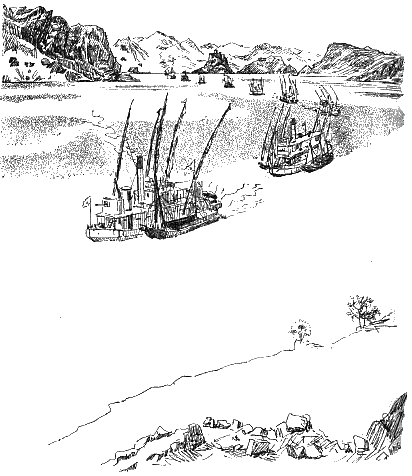
The Gaiassa of Egypt
Of Arab build and rig, and therefore
really of Asiatic origin, the Nile gaiassa is now a
fairly historic craft. Not only has it given birth to its
glorified and fashionable offspring the dahabia, the
luxurious home of the pleasure-seeking American or
Briton, but it has proved its utility as an engine of the
British Empire. It has taken a brave and arduous part in
three campaigns, and shares with the mule, the elephant,
and the camel, the distinction of having ministered to
the wants of the British soldier on the march.
Yet the gaiassa is in reality only a
wall-sided canal barge in build, with a lofty and
pretentious-looking stem, *1* and a disproportionately
vast rudder. Her sole claim to our admiration lies in her
splendid lateen sails. These wings still bear the Arab
name 'Kala trinkeit.' *2*
The mizen is probably a comparatively
late addition to the rig used in the larger boats as in
the seagoing coasters of the Red Sea, for sailing on a
wind or for setting goose-winged going free. This mizen
has of late years very much increased in area, especially
since the development in size of the boats themselves,
until now a large proportion of the Nile craft leaving
Cairo with a fresh wind will be seen to carry what amount
to main and foresails.
ANCIENT STEM
FROM A MODEL IN THE GIZEH MUSEUM
No one who has seen the gaiassa under
way can fail to be impressed by the length and power of
its great lateen sails, and no picture of Egypt is
perfect without that tall pyramid-point of white canvas
gliding along the sky-line.
As is so often the case among a
boating population, the fishermen and the gaiassa crews
are a people apart.
*1* This peculiar bow may be derived from a
high stem which was in vogue in certain Egyptian boats
which had a similarly exaggerated rise, as shown in
certain old models in the Gizeh Museum.
*2* Kala = sail ; trinkeit = trinchetto: the
foresail of the old Mediterranean lateen-rigged craft,
which, as already indicated, came from the Arabs
originally. The French arbre de trinquet.
They have their own thoughts, their
own ways, their own life, unaffected to a large extent by
the life over the banks above them. To a European
seaman's eyes their ways are peculiar and perverse;
nothing can be more astounding than to carry your
main-yard over your masthead, and even when close-hauled
to carry your sail set well to windward of the weather
rigging.
GAIASSA, CLOSE-HAULED
Yet the gaiassa captain does this and
much more, and he arrives just the same at his
destination.
One had been led to suppose that the
gaiassa skipper never attempted to beat to windward, that
he and his ship were only good for fair winds, and that
when in any difficulty he could only appeal to Allah, and
tear his beard.
Yet my friend Hassan Mahomet in an
eighty-foot gaiassa rather enjoyed a head-wind provided
it was at high-water season and he could get the wind
'true' over the banks, and he was well laden. For he said
it tested his rigging and showed that his gaiassa was
better than any of the white-painted dahabias which can
only row against wind, and for which he expressed the
greatest contempt. And he was accustomed to warp out of
the locks at the Barrage against a strong current,
without so much as a curse or a prayer, by the hands of
himself and his two sons, and the help of God. He knew
how the upper air was blowing, and by bracing in his
tack- rope he had a fair wind in the upper thirty feet 0'
sail although all was calm below that level.
ABREAST CAIRO
His main-yard was 84 feet long, *1*
and his mizen 50 feet. One was at first inclined to
shudder at the length of spar, but one soon found that
with the very short foot to the sail and the angle which
the whole can be given by slacking up the tack-rope,
there is even on a wind very little leverage likely to
cause a capsize. Moreover, owing to the give in the
long-yard, the upper portion of the sail does not hold
the wind when closehauled, and on this point of sailing
is generally flapping for a long distance down the
leach.
*1* The writer has measured a main-yard on a dahabia 134
feet long, and another 114 feet.
If small craft are capsized more
frequently it is because there is much less play aloft.
Their yard is stiffer, and the tack tackle is often
tauter in and irretrievably belayed. If under such
circumstances the sheet is also belayed out of reach, a
capsize is a manoeuvre of no real difficulty in a fresh
breeze coming tricky off the land.
The sail is generally set on the
starboard side of the mast, although the yard can be
shifted over the rope padding on the masthead if
necessary. In going to windward even on the starboard
tack, the heel of the yard goes far out to windward and
ahead, and the sheet is hauled down taut. The tack tackle
is slacked up and then adjusted to give the required
tautness to the leach and foot, and thus ensuring a true
lead for the sheet of the sail.
GAIASSA-WIND COMING FREE AFTER A BEAT
There is a vang about a third of the
distance in from the peak of the yard, and strong tack
tackle goes from the heel to the high stem. There is a
brail-rope from the sheet earing to the masthead, and
when taking in sail this is hauled up and the wind
spilled; the sail can then be furled by one or more men
going on the yard as may be required by the size of sail
and strength of wind. A long line is generally used for
tyer, with a number of running hitches, which with a
series of pulls from the deck can be shaken free one
after the other when setting sail.
The mizen is generally a beautifully
cut and shaped sail, and stands far better than the
mainsail on a wind.
GAIASSA RUNNING
The Arab sets it at all manner of
queer angles when off the wind, and its lateen shape
lends itself to being handled in a variety of
ways.
The boats are quite flat-bottomed, and
about five or six beams to length. The high bows which
are so peculiar are decked at a steep angle right up to
the stem-head. The bottom is protected by a certain
amount of keel-piece forward as well as aft, but this
gradually runs into the hull amidships. The reason of
this keel appears to be as much for protection in
grounding, which is necessarily of frequent occurrence
among the ever-shifting channels, as for the purpose of
giving grip in the water.
The high bow and mean stern are a
peculiarity of many Levantine small boats, but are
nowhere more accentuated than in the gaiassa. The
top-strake is very often built up with planks set in
dried mud, and partakes more of the coffer-dam than of
naval architecture.
FLOOD-TIME
It is generally inside the gunwale,
thus leaving a track outside for the men when quanting.
Owing to this coffer-dam construction being used also to
end off the clumsy transom-stern, the rudder of a fully
laden gaiassa often appears to be detached from the
stern, and by some strange device to be towing at some
distance behind the boat. But with her strange
combination of clumsiness, of serviceableness, and of
beauty, the gaiassa is undoubtedly not the least
remarkable of the wonders of Egypt.
The other Nile boat known well to
British and Egyptian soldiers is the less picturesque but
not less useful naggar, which has its home upon the
waters from the third cataract southward.
The naggar is not an aristocrat, and
has no notions about personal appearance. One who knows
her well declares she never paints. However that may be,
she is of the roughest in material and appearance. She is
constructed of stout baulks of saut, or heavy acacia
pilotica, pinned together by long iron nails clinched on
the outsides.
NAGGAR
The rig is a single balance-lug with a
boom along the foot, which is so set as to top the leach
of the sail up in the air like that of some of the
Pacific Islands canoes. The lateen is rarely used as yet,
although coming into favour. Imported spars are much in
vogue, but in default the masts, yards, and booms are
generally of Kakamut wood from the upper Nile. These
boats are all sizes - from thirty feet upwards - and have
the heavy gaiassa form of rudder. In coming northward
down river, and against the prevailing wind, they are
fitted with outriggers and long sweeps, and rowed
double-banked. As in many parts of the Far East, the men
stand to their work facing forward, and take two or three
steps at each stroke.
In descending a cataract or rapid the
Nile boatman profits by the up-stream wind to head his
ship upriver, and sets sufficient sail to keep way
against the current. Thus while the vessel keeps
steerage-way and is well under command, he steers her
slowly stern first down the rapid. If the wind lightens,
or the stream gets stronger or more rocky, he makes sail;
and when the boat reaches slacker water, sail has to be
proportionately reduced. The enormous rudder of both
gaiassa and naggar is thus explained, it being used with
great effect, as in other fresh-water craft which
navigate in strong currents, to swing the boat athwart
the current, or swing her head up to it when rocks are
threatening. The Thames bargeman knows something of the
same art in going through bridges on a strong tide; but
the latter is admittedly tame in comparison with taking a
Nile rapid stern first.
The ancient Egyptians were adepts at
Nile drifting, and Herodotus gives an account of what is,
I think, the earliest form of drogue which is known, made
of wooden frame and matting, by which the boats' heads
were kept down-stream and travelling with the current,
while a stone sinker was used towing deep at the
after-end to keep the course straight.
The lower waters of the delta of the
Nile and the Suez Canal and its salt-water lakes make a
large navigable district for shallow big-sailed boats,
mostly of the gaiassa style. The lofty and very narrow
form of sail shows that they are accustomed to inland
waters, in striking contrast to the lateen of the Western
Mediterranean, or even of the sea-going dhow of the
East.
THREE-MAST GAIASSA, NILE DELTA
Great as is the interest of the upper
Nile, this land of the lower delta is even more full of
picturesque and peaceful Eastern life. It is the home of
a simple and hospitable folk, who live by and upon the
wind swept waters of Lake Manzala and the big winding
waterways leading to such places as Damietta, Ismailia,
Alexandria, and Port Said, where much boating activity of
interest prevails. The pelican and the king-fisher and
countless duck add interest to every day's sail; and
although the villages are more squalid generally than
those of Upper Egypt, they are not lacking in beauty and
quaintness and in the charm which the wide horizon of a
fen-like country always has to offer.
At Suez a seaworthy type of lateen
boat is used much more of the strictly Arab build. There
is a long, sharp-pointed, overhanging bow with sharp
sections, great beam amidships where the mast is stepped,
and a raking transom-stern.
SUEZ SHORE-BOAT
They have the horizontal painted lines
and the white bottom so frequently seen in Arab sea-going
vessels. The sail is of the Arab cut, with several feet
of luff below the heel of the yard. It is invariably set
on the starboard side, and the tack, as in the Adriatic
lugsail, is carried well off towards the gunwale in order
to keep the sail off the mast and prevent a back-sail
when on the starboard tack, and especially when
close-hauled. In fact, in these boats it is brought right
to the gunwale on the starboard bow. The yard is
generally kept standing, and the sail hauled out along it
by an outhaul when set, as in many small Mediterranean
lateens, and in the Cambodian lugsail boats of the Great
Lake. When furled it is bunched in at the mast, but the
fore triangle of course remains. It does not, however,
hold much wind. A small fore staysail is used in the
larger boats, and is a great assistance both to speed and
staying power.
SUEZ SHORE-BOAT
These boats in a strong wind are very
well handled by their swarthy crews notwithstanding the
long white robes, which, when wet and wind-blown, form no
small handicap to agility.
The Dhow
No craft has played a greater part in
the world's history than the dhow. The lateen yard is as
much the emblem of the Faith as is the crescent. Wherever
the great Mohammedan creed has been preached wherever the
sword of the Faithful has carved its gory path, there the
lateen-sail has heeled to the wind and the long grab-bow
has cut its way. Thus the lateen is the rig to this day
of all the Mohammedan, and not a few Christian, sea-coast
people from Malabar to Gibraltar.
The true baggara, bagala, *1* or Arab
dhow, *2* the probable parent of all the lateen-rigged
offspring, is now mostly to be met with in the Red Sea
and eastward to the Persian Gulf, Karachi, Bombay, along
the Malabar coast, and down the coast of Africa as far as
Zanzibar, making its voyages with the fair wind of the
favourable monsoon, and quite capable of holding its own
in the hard weather often to be met with in the Indian
Ocean.
*1* = 'mule,' and therefore a cargo-carrier.
*2* A small gaiassa is known in the Red Sea as
sambuk.
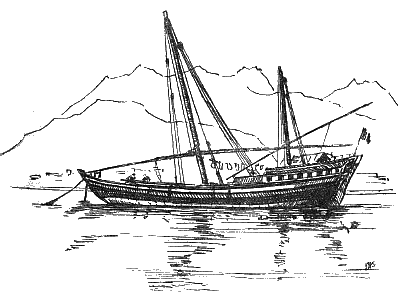
IN ADEN HARBOUR
Next to the Chinese the Arabs have
been the most skilful and daring seamen of the ancient
East, and in the dhow they have devised a fast, able,
sea-going type of ship, not a whit less remarkable than
the junk.
Notwithstanding local differences of
detail, these vessels vary very little as a class. They
are generally grab-built, having a long overhang forward.
There is great beam and rise of floor, and a very raking
transom-stern. The shell planking secured to the wooden
frames is generally worked in two thicknesses, with a
layer of composite between, thus making the craft very
dry and giving great durability.
ADEN OPEN BOAT
In fact, many of the dhows still to be
met with are much older than their owners, and have been
sailed by three generations of skipper -- grandfather,
father, and son. There is generally a high poop and
fo'c'stle deck, the rest of the vessel being practically
open. Dunnage or cargo-battens are nailed to the inside
of the frames to keep cargo off the bottom, and rough
planks laid loose over cross-beams provide a fore-and-aft
gangway.
The pattamar used for the Bombay
coasting trade has generally regular bulkheads dividing
the poop and fo'c'stle from the hold.
The rig consists generally of main and
mizen lateens. The mainmast is a big spar stepped
amidships, with a great rake forward, to enable it to
carry the great weight of the long lateen yard in the
right place. This yard is generally about the over-all
length of the boat, and in the larger baggara it often
consists of three or even more pieces spliced
together.
BATELO
It is hoisted by a stout halyard,
often in two parts, passing from the fore side through a
sheave at the masthead, with an enormous three-sheave
wooden block stropped to the end. The purchase leads to a
four-sheave block placed just in front of the poop. *1*
There is very little rigging, usually a forestay and a
couple of runners on each side. The sails are seldom
reefed, but two or three sails of different sizes are
carried, to be bent according to the weather.
*1* This appears to have been the usual lead for the main
halyard in the ancient Egyptian ships used in the Red Sea
in the Punt Expedition about 1600 B.C. (v. Holmes's
Ancient and Modern Ships, and Torr's Ancient
Ships). It is similar to that of the Nordland jaegt
of Norway (v. chap. iii).
The mizen-mast is a much smaller spar,
stepped well inboard a few feet from the fore end of the
poop, with a smaller rake, however, than the foremast.
This sail is seldom set when off the wind, but is used in
beating to windward a point of sailing in which, like
most Eastern sailors to whom time is no object, the Arabs
but seldom indulge. None but a fool, or the impatient
Western, will beat against a head-wind if there is an
anchorage within reach.
GYBING TO CHANGE TACK, ZANZIBAR
In changing tacks the Arab puts his
helm hard up, and wears round, letting the sail fly out
forward, and the yard come round over the masthead; the
sheet is then caught and hauled aft on the new tack, for
which, of course, the ship must be luffed to the wind in
order to spill the sail in the absence of any proper
tackle on the sheet. In the Mediterranean the lateen is
allowed to stand against the mast; but, though the heel
of the yard may stand some way out to windward, a certain
portion of the sail is liable to be aback against the
mast and form a back sail.
The Arab sailor has his own ideas of
painting his ship -- a light-coloured bottom, black
topsides with two white lines, the lower one of
considerable breadth, are the rule. The poop is generally
considerably ornamented, its windows or ports, of which
there are often a number, being picked out much in the
style of the old wooden sailing-ship of a century
ago.
There is, it must be confessed, a good
deal of that happy-go-lucky, loose-rope-end style about
the seamanship of the modern Arab sailor, which for some
reason or other seems well-nigh inseparable from the
East. The old-time sea-song has not gone out of fashion
in the dhow any more than in the junk, and there is the
same inability to keep quiet and execute orders in an
emergency.
Getting up sail is a very lengthy, not
to say noisy, operation. The yard and sail are very
heavy, and take the whole force of the seventeen men or
so who form the crew to hoist. When all is ready an old
man begins a chant in a high-pitched falsetto shriek; the
hands yell 'Ho !' and pull more or less together. They
then keep time by calling out the name of Mahomet, or
some sheikh or place, the name being always started by
one man and taken up by the rest as loud as lungs permit,
very much after the style of the old sea chantie of the
square-rigged ship. It makes, however, little difference
to the Arab what is called out, so long as plenty of
noise is made.
It takes half an hour to get up sail
in ordinary weather, and more if there is any wind, while
shortening sail is an equally lengthy process, and in
squally weather becomes really dangerous, as no attempt
is usually made to begin operations until the force of
the wind is becoming heavy.
The sail is often furled on the yard
standing, one man going aloft and starting at the outer
end, and in light winds he goes on furling and tying up
the bunt steadily all the way down until the whole sail
is furled. The usual occupations of a crew include laying
up rope from small pieces of rough bass, of which an
unlimited supply is generally carried.
FISHING CANOE, OFF RAS IMRAN
They also occasionally wash their
solitary garment, made of blue or white cotton after the
fashion of a nightgown, this being preceded as a rule by
a careful examination of all the folds for lice, with
which too often the older craft are infested.
The crews are very easily alarmed, and
lose their heads in an emergency in a manner which would
do credit to a Russian battleship. They mistake
lighthouses for ships, and tide-ripples for sandbanks,
and every discovery of the sort is followed by a wild
scene of excitement and confusion, accompanied by
screaming and shouting from every man on
board.
Three kinds of dhow *1* used to be
generally recognised on the African coast: the bugala or
bagala, the genuine dhow (which is the most numerous),
the bateele, or batelo, and the badane of Persia and
Arabia. The matapa, a light open boat, which was used a
great deal in the slave-trade on the rivers and
estuaries, is the only type of boat which is not of dhow
origin. It has a square sail, and is really of the more
primitive canoe type. They yet have a deepish forefoot,
and set the tack of their peculiar looking sails very far
forward in a manner which bespeaks Arab influence. This
type of boat one has seen in a heavy onshore sea off Ras
Imran, making wonderful weather of it to windward. They
appear now to be used chiefly for fishing purposes by the
Somalis, but are not often met with.
The Gehazi which is the local name of
the Arab dhow south as far as Zanzibar and Dar-es-Salaam,
is of the same build practically as the Red Sea sambuk.
Some of these boats are of first-class size, and are in
fact true baggara, with high poops, mizenmast, and all
complete. Others omit these two features, but retain the
others generally characteristic of the smaller Arabic
seafaring vessel known as batelo.
Much interest inevitably attaches to
these vessels, for they are the same to-day as they were
in the early part of the last century, when the British
Navy carried on against them upon the coasts of Africa,
and especially upon the east coast, what was practically
a long-continued, difficult, and dangerous war. Before
the construction of the Suez Canal, communication with
the whole of this coast was slow and uncertain, and the
British public never fully realised the arduous character
of this service, or the remarkable success achieved by
the patience and perseverance of the officers and men of
the Royal Navy in the face of the greatest difficulties
and dangers.
*1* The usual dimensions of the larger baggara
are: Length, 8.5 feet; beam, feet; depth, 12 feet;
tonnage, 200. The pattamar varies from 60 to 200
tons; the dimensions for the larger: Length, 76 feet;
beam, 22 feet; depth, 12 feet. The batelo is only
about 30 tons: length, 51 feet; beam, 10 feet; depth, 4.5
feet; and the Red Sea sambuk is generally from 18 to 20
tons only.
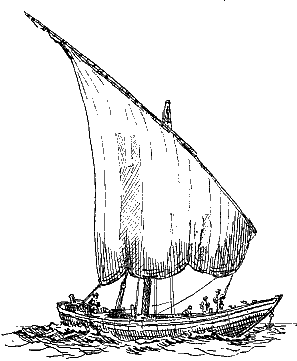 ZANZIBAR
GEHAZI
ZANZIBAR
GEHAZI
A few records of the service remain
which will repay study, if only to show what could be
done navigating open boats by men who knew true
discipline and had no souls for notoriety. But more than
this: it is to these old gehazis and their forerunners
that we owe the only civilisation which has ever reached
and touched the life of the East African native. The old
builders of the Great Zimbabwe, Semitic or otherwise,
came by sea. They disappeared, and practically left
nothing of influence behind them.
The Arab came in later times, and if
he brought a curse to many in the slave-trade, he yet
converted a third of Africa to the faith of Islam, and he
introduced hundreds of thousands of negroes to some form
of Eastern civilisation which they would never have known
and still less risen to but for him. The Zanzibar of
today is no African kraal; it is an Asiatic town set in
Africa.
They have the very sharp bow
with hollow lines familiar in the dhow; the stern, which
is greatly raked, is not nearly so striking to the eye,
but is full and round. The keel is often arched, which
gives a most peculiar appearance to the boat when out of
water. The sharp, deep forefoot takes the place of the
modern dagger or fin keel, now so common in our
small-raters in home waters, and adds enormously to the
weatherly and turning powers of the boat. The whole sail
is placed very far forward over this portion of the boat
as in the dhow, the centre of effort and centre of
lateral resistance being thus given almost the same
relative positions as the designer of a Clyde or Solent
rater would choose. Yet to look at the Bombay boat or at
the dhow for the first time, one would think that they
must infringe every principle known to Western
boatbuilders. In reality they arrive at an identical
result, albeit by a method most peculiarly their own. The
lateen reaches as far south as Ceylon, where it is seen
in combination with staysails and fore-and-aft mizens,
not infrequently with the outrigger, which is such a
striking feature of the Cinghalee boat-building.
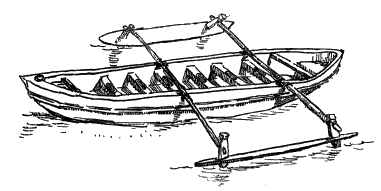
ARAB DUG-OUT GHARAWA
17 FT. BY 2 FT. 6 IN.
(Upper Strake pegged on; gaily painted to attract
market-women.)
The outrigger appears to be scarcely a
true Asiatic method of construction, and has probably
come up to Ceylon and Zanzibar from the south and east.
It is the first effort of the savage to afford stability
to his dugout.
The dug-out form of construction is
the simplest and most effective for navigation in
protected waters, and in capable hands. In well-timbered
countries, such as Burma and Siam, long craft of 100 feet
by 8 or 10 beam are often made in this manner, and are
heightened when necessary by the addition of top strakes
at the side. But the fault of the dug-out is always lack
of beam, and therefore of stability.
The poor fisherman with his humbler
boat, who needs to carry fish, or nets, or rice, soon
feels the want of stability of his boat.
On the Me Kawng, the great river of
Indo-China, the Lao boatmen tie bundles of bamboo along
the gunwales of their dug-outs, many of them going 60
feet in length, by this means not only giving such
stability to their boats as to render a capsize even in
the most violent rapids well nigh impossible, but also
rendering them unsinkable by reason of the air
compartments provided by nature in the bamboo.
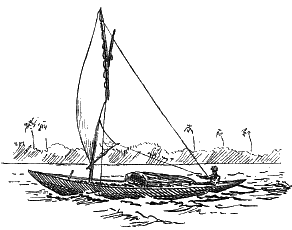 ON
THE HUGLI
ON
THE HUGLI
This form of outrigger, or side
air-chamber, would probably prove very efficacious at
sea, but it has the disadvantage of greatly retarding
speed.
The sea-going canoe-man has therefore
more generally adopted the better known form of outrigger
fixed parallel to the keel of the boat at a distance of
two or three beams, by two or more transverse pieces, as
in the Gharawa of Zanzibar. These
outriggers in no way retard speed, but, floating lightly
on the surface, give great stability, and enable the
smallest dug-out to carry a press of sail which renders
them very speedy off the wind.
It is in the big rice-carrying boats
of the rivers and canals of India that we find ourselves
in the old world of boat construction which has long
disappeared from more Western lands.
BENGAL MALAR PANSHI
The pulwar and malar panshi are both
typical types of the old-fashioned boat architecture of
Hindo-Stan, the rig that of the simple squaresail, the
hull either a long dug-out in general form reminiscent of
the main outline of not a few ancient Egyptian boats, or
built on a dug-out frame after the manner of many
Indo-Chinese river boats. In every case there is the high
steering platform, and either the primitive form of fixed
steering-oar turning upon its axis, and fixed to the
hull, which is seen alike in the Lao river boats in Siam
at the present day, and in the Egyptian vessel of the
eighteenth dynasty, or the peculiar Indian balance rudder
in which a considerable portion of the area of the rudder
is placed forward of its turning axis, which is
essentially a development of the former by a mere
increase in the size of the blade.
BOAT FROM THE TOMB OF MAHITI
PRINCE OF SIYUT
• • •
NEAR BURDWAN
The dinghy of Calcutta is a striking
old-world form, admirable in construction and design.
Although not a true sailing-boat, it carries sometimes a
low spritsail to assist its rowers in the strong tide of
the Hugli. Its form is strangely like that of an ancient
Egyptian boat in the Gizeh Museum from the tomb of
Mahiti, Prince of Siyut.
The Maldives
Of true sea sailing-boats the Indian
Ocean has but few with any great peculiarity of mast and
sail. The Maldive Islanders, formerly contented with the
mere outrigged dug-out, have in the last half-century
developed some quite good boats of their own.
PULWAR, BENGAL
• • •
MALDIVES
With high stem and stern and peculiar
short-yarded lugsail, the open boats remind one not a
little of the Sondmoersk yawl of Norway, but with the
true Oriental love of a high scat for the steersman, the
<-> of Herodotus and Euripides, they have improved
on the more Northern model to the extent of a flat
platform aft upon which the helmsman is accommodated. The
hull is of a particularly wholesome and able type for an
Oriental model, with clean lines and easy run.
MALDIVES OPEN BOAT
(FROM A MODEL)
• • •
MALDIVE TRADER
The larger class of boat is decked in
with somewhat elaborate and comfortably arranged
deck-houses, and carries a small topsail in fine weather.
The powerful grip of the forefoot, the only resemblance
to the dhow-build which they present, enables the centre
of effort of the sail area to be placed far forward.
These boats have power and speed, and are a fine class of
sea-boat.
The most remarkable vessel, however,
is the larger Maldive trader, running to a hundred tons
or more in size. She is fully decked, with considerable
deckhouses and big overhanging forecastle, very like that
of Columbus's ship the Santa Maria and other vessels of
the fifteenth century. *1*
A CARAVEL
The rig, moreover, is the three-mast
arrangement which was general in Europe about that time.
A tall mainmast carries a big main squaresail set high up
with topsail and occasional small topgallant sail. The
mizen carries a fore-and-aft gaffsail, taking the place
of the lateen mizen in the fifteenth-century
ship.
*1* It is noticeable that in the main outline of hull, in
the general disposing of the three masts, and in the
simple squaresails, the caravel of this period had
altered but little in general plan, although largely
improved in detail of construction from the ships of
Pliny's time, and even the single sail appears to have
been known as early as 50 AD. See Torr's Ancient
Ships, Holmes's Ancient and Modern Ships, etc.
etc.
Forward is a raking foremast carrying
a square foresail well out over the bows, in the same way
as the ancients set their <->. One may meet these
vessels occasionally as far north as the Hugli, and with
fair monsoon they are rapid passage-makers, but beating
to windward is not their forte.
Burma
Although only a fair-wind sailor, one
of the most remarkable craft to be met with is the Burma
riceboat, one of the biggest and smartest forms of river
boat in the world, and very far ahead of the rough Bengal
rice-carriers in every particular.
UPWARD BOUND
Owing to the prevalence of the
southerly sea breeze which blows upstream for many months
after the end of the cool season, these boats are rigged
only for running up against the stream. When going
against the wind they punt or pull along with the
current, and never beat to windward. The squaresail, or
square-headed lug, is the only sail practically known in
Burma. And in these boats the mast is a triangle formed
of two spars meeting at the apex in a manner already
familiar to us in ancient Egyptian drawings of the third
and fourth dynasties, *1* and still also used in the Red
River of Indo-China. The yard is a standing spar
supported by a network of halyards. The sail and its
topsails are brailed up to the mast, and when set are
hauled out along the yard from the deck. A crowd of these
craft running before the fresh south wind up the broad
Irrawadi form a fine sight in their way.
*1* Vide Holmes's Ancient and Modern Ships,
etc.
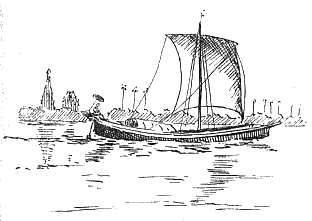 IN
A BURMA CREEK
IN
A BURMA CREEK
The most beautiful work in these boats
is about the stern and the steersman's seat, upon which
the Burman loves to bestow his most elaborate and careful
woodcarving. Here the classical scholar may recognise his
old friend the ancient <-> sitting in state raised
aloft beneath his <->; and he may study almost the
identical method in which Greek heroes and Roman
merchantmen used to sling their oar-blade rudders on the
quarter, following the Egyptian example, which takes one
back to the very earliest days of man's boat-building.
*1*
Some up-river forms of boats among the
Burmans and Talaings are very pretty and elegant. The
fiddlehead, clipper or schooner bow shape *2* is a great
favourite, although, owing to the shallowness and
rounded-up form of the ends of these canoe-built craft,
the lower edge of the stern is frequently carried right
out of water.
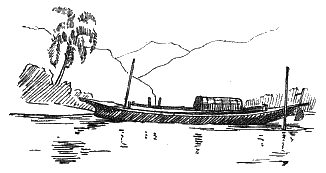
UP-RIVER BOAT
Taking all in all, the Burmans, and
other boating races on the Indian Ocean, are neither so
competent or so courageous in handling boats, nor so
skilful in designing them, as are the races immediately
to the west and to the eastwards; and in a limited
experience of river boating with Burmese, the writer was
more often in actual peril from want of watermanship, in
strong currents or rough water, than ever was the case
during several years' journeyings among Chinese and
Burmese often under most unfavourable
conditions.
ON THE IRRAWADI
*1* The modern method of slinging the rudder upon the
stern-post by pintle and gudgeon only dates in Europe
from the beginning of the four fourteenth century, the
ancient <-> or quarter steering-oars having been
retained in all Western ships until then. This innovation
was a most important advance in shipbuilding, making
possible for the first timer a large Increase in tonnage.
The Chinese adopted the stern-post as the place for the
rudder probably at a much earlier date, but they have
always placed it in a rudder-trunk, somewhat similar to
the centre-board case, through which the deep rudder
could be hoisted up by means of winches when entering
shallow water.
*2* The first record we have, so far as I am aware, of
this beautiful form of bow, is in the representation of a
merchant-ship on the painted vase found at Vulci, in
Etruria, now in the British Museum, of about 500 BC.,
which a hull as beautiful in shape as it is seaworthy in
design. - Vide Ancient Ships.
OFF MERGUI-REEFED
An extremely pretty type of small
sailing-craft is that used in the Mergui Archipelago. It
has often the distinctive form of bow and stern of the
Burmese and Talaing boat people, but the general
appearance and the rig are very Malay in character. A
good many of the larger boats are built up, upon the
lower dugout bottom-piece, in wide strakes, and have
pretty clipper stems and overhanging counters, and in the
last decade were extensively used in the pearl fishery
which flourished among the islands after the discovery of
the Pawe Bank early in the nineties.
MERGUI HARBOUR
They form a very lively and
characteristic feature of the beautiful little port of
Mergui. At low water they may be seen lying in all
positions upon the mud, or sailing with the seabreeze up
the customary tracks in the mud-banks' terra firma. At
high water they come running in under mainsail, or may be
seen beating out with gunwales awash, throwing the water
halfway up the foresail. The larger ones have a
comfortable little house or shelter aft, just before
where the steersman sits. The rest is decked, but as is
usual with warm water sailers, is not
water-tight.
A smaller form is little more than a
long dug-out canoe, looking like a snake upon the water,
and is used by the fishermen of the islands. They carry
the same peculiar square-headed lugsails, with the
foremast right in the bows; and dodging about upon their
fishing-grounds in a lop of a sea, half a hundred of
these boats form a really beautiful picture, and a
remarkable example of what small craft well handled can
do.
MERGUI PEARLER
In case of bad weather all of these
boats are of course obliged to cut and run for the lee
side of the nearest island. They have too little body to
claw off a lee shore in any weather; but with centre or
lee-boards fitted to them, a little more ballast, and
higher sides, they might give a very good account of
themselves, the hull being without dead wood of any kind,
and formed with long clean curves. The writer's
experience of them, though limited to a short cruise of
five days' duration, was not dull, the squally time about
the beginning of the rains not being ideal cruising
weather.
ON THE FISHING-GROUND
The crew were Burmans, not accustomed,
as it turned out, to the boat, and ignorant of the fact
that the lower strakes had all been opened out by the hot
weather.
FRESHENING UP
In one of the terrific blows heralding
the break of the monsoon, we drove up the Tenasserim
estuary in a sinking condition, with the mainsail jammed
at the masthead, and the water pouring in solid,
underneath the deck. We could only run; any attempt to
bring her to would have capsized her at once, and handed
us over to the crocodiles waiting along the
mud-banks.
The mainmast was tough, and the
available knives blunted by six weeks' jungle-marching.
It was a question of moments, until the mainsail
obligingly split up and blew away to leeward, thus
enabling us to get in what remained. The Burman sarang
declared between his tears that an angel had gone up the
mast to clear the sail -- an explanation which my Siamese
and I were disposed readily to accept.
RUNNING HOME
After getting the water under, we
sailed her through the squalls of that windy night with
more circumspection and tenderness than I think I have
ever felt called upon to display upon any similar
enterprise.
But with a well-caulked boat and
ordinary weather, sailing among the forest-covered
islands of this beautiful archipelago and exploring its
wide jungle-lined estuaries with the cheery-natured
Burmese for your companions, is a perfect form of
seafaring which can be strongly recommended to any
traveler of grit.
There is plenty of big-game shooting
inland towards the main range, and the flora and fauna
present a most interesting combination of the
peculiarities of India and Malaya.
ON THE MUD 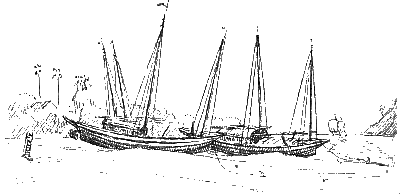
The Karrens of the hill are cheery and
enthusiastic sportsmen, and if the sport often involves
hardship and privation as well as danger, it is none the
worse for that, and is never lacking in variety and
incident.
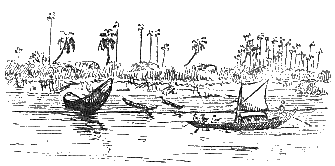
THE BANKS OF THE HUGLI


 ZANZIBAR
GEHAZI
ZANZIBAR
GEHAZI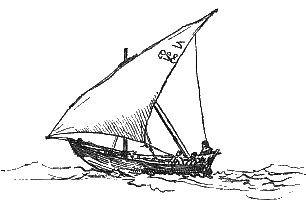 The
Bombay boats carry this turning power to a fine art, and
there is a story of an old English sailor who, when he
put the helm up, got so giddy at the speed with which his
strange prize flew round that he forgot to check the
helm, and the boat went on turning circles, to the wonder
of the onlookers, until at last he got over his surprise
and steadied her on her proper course.
The
Bombay boats carry this turning power to a fine art, and
there is a story of an old English sailor who, when he
put the helm up, got so giddy at the speed with which his
strange prize flew round that he forgot to check the
helm, and the boat went on turning circles, to the wonder
of the onlookers, until at last he got over his surprise
and steadied her on her proper course.
 ON
THE HUGLI
ON
THE HUGLI IN
A BURMA CREEK
IN
A BURMA CREEK

